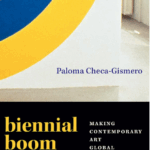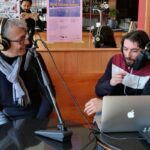Editorial | Fall 2018
Grant Kester
Welcome to FIELD‘s 11th issue. We are delighted to present a special issue focused on the interrelationship between artistic and anthropological research. This issue has been guest edited by Elpida Rikou and Eleana Yalouri. Elpida and Eleana are well suited to develop this topic, as each of them has made a significant contribution to the emerging dialogue between art practice and anthropology. Elpida is an anthropologist and visual artist with a Ph.D. in social psychology who has taught at the Athens School of Fine Arts. Elpida has edited a number of important books, including the anthologies Anthropology and Contemporary Art (2013), Voices ( Φωνές/Fones, 2016), with Panagiotis Panopoulos, and Value (Αξία, forthcoming) which she coedited with Eleana Yalouri and Apostolos Lampropoulos. Elpida also founded a number of innovative artistic research projects, including TWIXTLab, Learning from documenta (which she established with Eleana), and Value/4th at the Athens Biennial. Eleana is an anthropologist who teaches at the Department of Social Anthropology at Panteion University of Social and Political Sciences in Athens, and earned a Ph.D. in Social Anthropology. She has written widely on the cultural politics of art, both historical and contemporary, with a particular focus on the complex forms of hierarchy and domination that characterize the appropriation of cultural practices. Her books include The Acropolis: Global Fame, Local Claim (2001) and the edited volume Υλικός Πολιτισμός. Η Ανθρωπολογία στη Χώρα των Πραγμάτων (Material Culture: Anthropology in Thingland) (2012).
One of the founding premises of our journal has been the need to expand the disciplinary frame employed by art historians and critics in attempting to analyze socially engaged art, with a particular focus on new research methodologies that are capable of addressing the forms of praxial knowledge generated by these projects in a more substantive manner. The advantages of anthropological research in this regard are twofold. First, the anthropological tradition has engaged a much broader range of cultural practices, from religious rituals to protest movements to the spatial politics of walking. As a result of its recognition of the value of “prosaic” forms of cultural production, the field is less concerned with imposing a defensive binary opposition between “art” and other practices, and often better able to grasp the significant points of differentiation as well as consilience. This is especially important in the case of socially engaged art projects, which are trans-disciplinary by nature. Second, anthropological research has a particular investment in forms of knowledge generated through direct observation and interaction, and focused on the complex interrelationship between lived experience and the pre-conscious horizons formed by normative discursive traditions and political systems. Conventional art historical methodologies, on the other hand, are often organized with reference to the perceptions of a hypothetical or generic viewer, rather than actual viewers or participants. This is the product of an underlying theoretical tradition which contends that artistic production must remain temporally displaced from its moment of origination in order to preserve art’s unique critical capacity. It has resulted, however, in the relatively crude reception models typical in contemporary art criticism. Critique and criticality is produced differently in the lexicon of anthropological research, and this difference can be both productive and provocative for art historical research.
Eleana and Elpida’s FIELD issue presents a series of essays exploring the interface between artistic production and anthropological research by leading figures in the field. These essays grew out of a site specific research project that they organized in response to the decision to stage documenta, the famed German art exhibition, in Athens in 2017 (documenta 14). Documenta’s decision to re-locate, in part, from Kassel to Athens can be seen as a bid to remain relevant in a rapidly changing art world, by appropriating the nomadic exhibition model pioneered by organizations such as Manifesta in Europe. The result was an uneasy juxtaposition between an arts institution endowed with extremely high levels of both real and symbolic capital, and a city living through the profound cultural and economic dislocations of rampant neo-liberalism. Eleana and Elpida’s project, Learning from documenta (2017), brought together a network of anthropologists, artists, activists and researchers to explore the cultural politics involved in bringing documenta to Athens (a wall graffiti at the time, located near documenta’s offices, read: “Dear documenta: I refuse to exoticize myself to increase your cultural capital. Sincerely, oi ithageneis [the natives]” [1]. Learning from documenta was a multivalent undertaking, combining workshops, field research and artistic projects, lectures, discussions, a fanzine and an archive, among many other elements. While the title of the project was Learning from documenta, an underlying question posed by the work was whether or not documenta could “learn” from Athens. Or, alternatively, would Athens remain a convenient locus of the political real to be appropriated by documenta’s bureaucratic apparatus? As Elpida observed in a 2017 interview:
Documenta 14, in particular, adopts a discourse of the oppressed other, of the refugee, of the trans subject, of the marginalized indigenous, and at the same time, Documenta is a powerful institution that comes to a city in crisis. . . When activists acquire an important role in an important institution, their discourse changes context and creates other effects. This is a major issue and we have to go a step further. Art production today has to think about the relationship between grassroots projects and the institutions that adopt the same language.[2]
Here Elpida has identified an issue that has direct relevance for the broader field of socially engaged art. What does it mean when mainstream arts institutions, densely imbricated with the flow of global capital through both the art market and the cultural protocols of the nation state, choose to identify themselves with the dispossessed? This is a problem familiar to us from the rampant institutionalization of socially engaged art in the U.S., epitomized most recently by Creative Time’s fall 2018 “Gala” celebration of artist Pedro Reyes, co-chaired by Mary-Kate Olsen and her husband Olivier Sarkozy. Mary-Kate, along with her sister Ashley, have a net worth of over $400 million dollars, while Sarkozy is a banker and half brother of the former French President, with a net worth of at least $60 million dollars. What does it mean when a form of artistic practice that is, at least ostensibly, engaged with issues of social justice and capitalist critique has accumulated sufficient cultural cachet to attract the acquisitive interest of the super wealthy? These are questions that we’ll continue to pursue in FIELD in the future. Elpida and Eleana’s special issue provides us with an invaluable guide as we begin to answer them. We are grateful to them, and to all of their contributors, for their insights and generosity.
[1] Elpida Rikou & Eleana Yalouri, “Learning from documenta: A Research Project Between Art and Anthropology,” OnCurating, issue 33 (June 2017). Accessed on-line October 10, 2018: http://www.on-curating.org/issue-33-reader/learning-from-documenta-a-research-project-between-art-and-anthropology.html#.W74qoBNKhTY
[2] Risa Puelo, “The Messy Politics of Documenta’s Arrival in Athens,” Hyperallergic (April 10, 2017). Accessed on-line October 10, 2018: https://hyperallergic.com/371252/the-messy-politics-of-documentas-arrival-in-athens/







